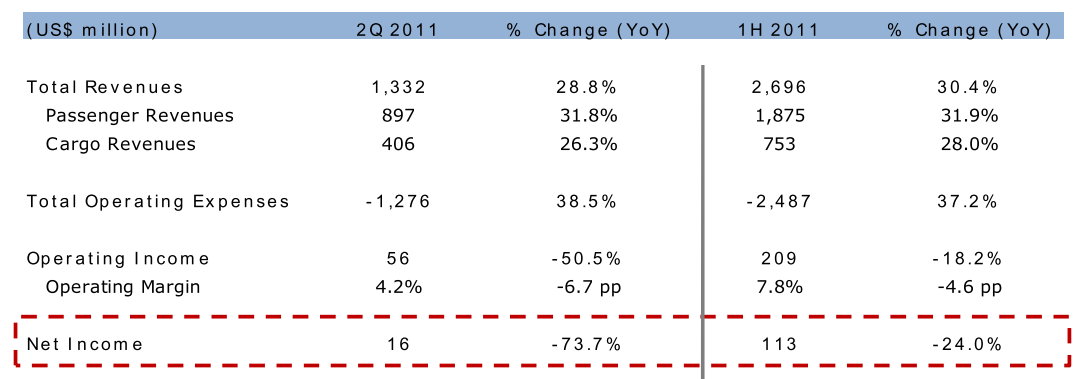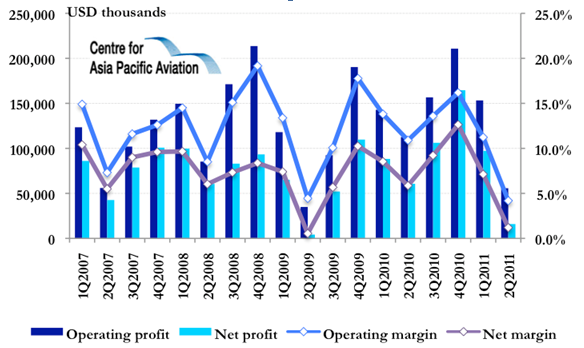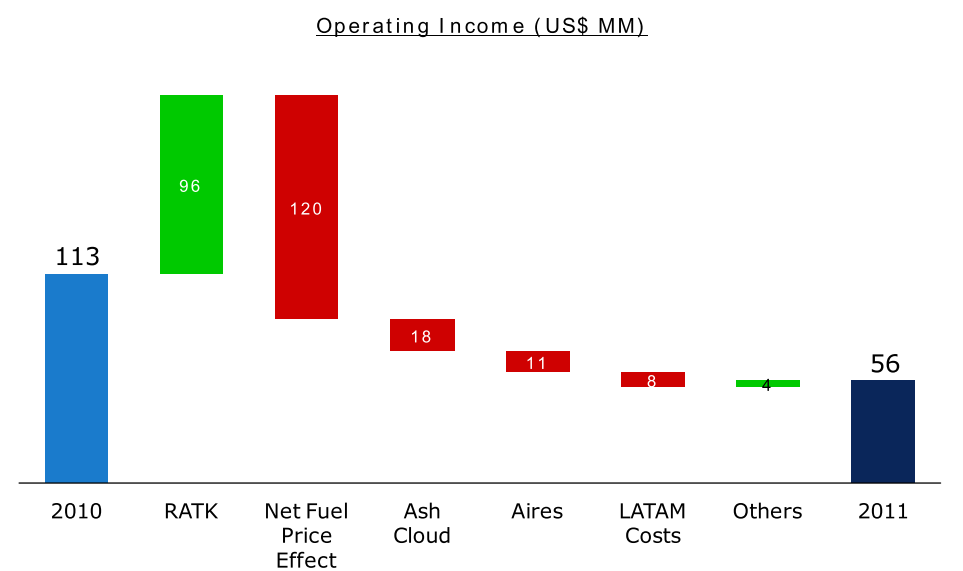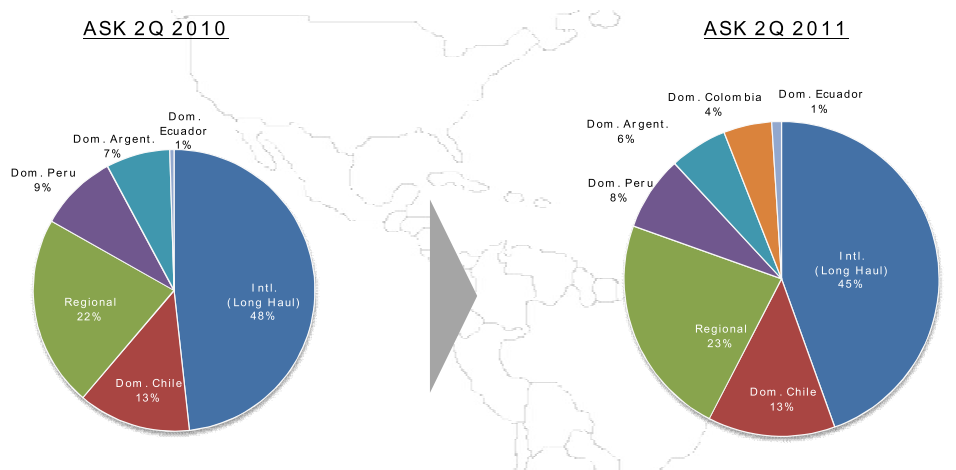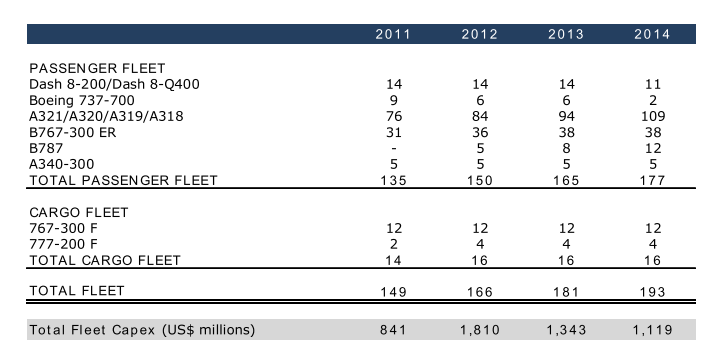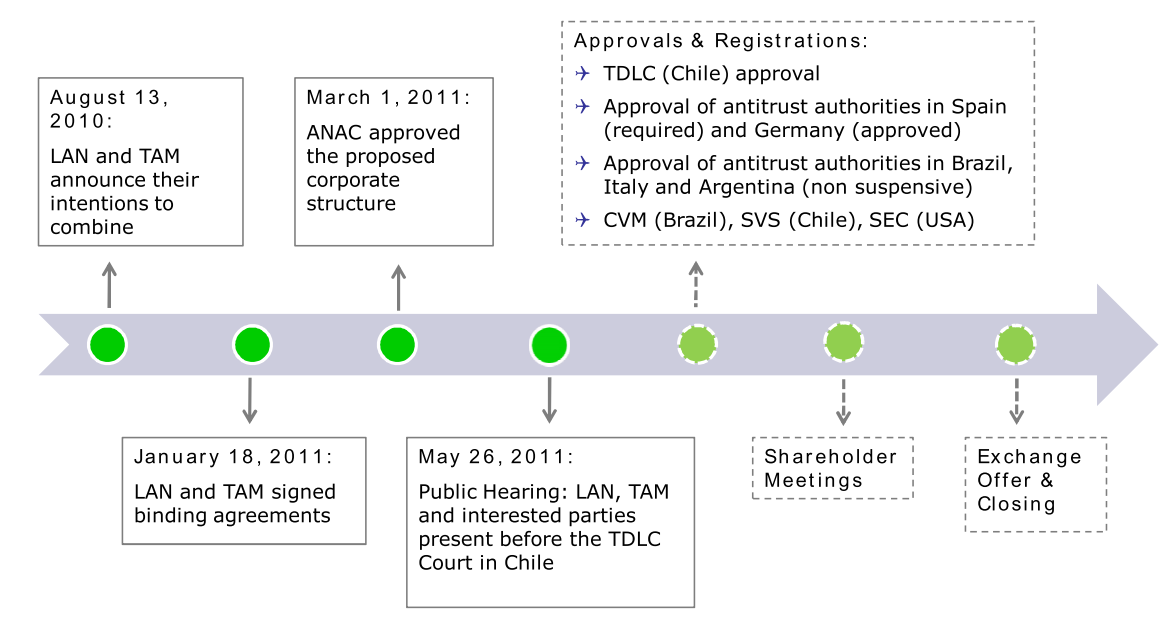LAN blames fuel prices, ash cloud and Aires for unusually small profit
LAN turned a net profit of only USD16 million in 2Q2011, a 74% decrease compared with the USD61 million profit from 2Q2010 and the airline group's lowest profit for any quarter since 2Q2009. LAN, which over the past several years has had one of highest airline profit margins in the world, also recorded its lowest operating profit margin in five years. The Chile-based airline group said its 2Q2011 results were impacted by higher fuel prices, operational disruptions caused by volcanic ash and losses at new Colombian subsidiary Aires.
- LAN's net profit in 2Q2011 decreased by 74% compared to the previous year, reaching its lowest level since 2Q2009.
- The decrease in profit was attributed to higher fuel prices, operational disruptions caused by volcanic ash, and losses at the newly acquired Colombian subsidiary Aires.
- Despite a 29% increase in revenues driven by strong demand in the region, operating costs rose by 39%, primarily due to increased fuel costs and aircraft rental and maintenance expenses.
- LAN's operating profit margin dropped to 4.2%, the lowest in five years, compared to 10.9% in the same period last year.
- The weak performance prompted LAN to reduce its capacity growth for the remainder of 2011, expecting a growth rate of 14%-16% instead of the initially planned 20%-22%.
- LAN's merger with TAM faced further delays, with the decision from the Chilean antitrust court expected in August, potentially pushing the closing of the transaction to 1Q2012.
Revenues at LAN surged 29% in 2Q2011 to USD1.332 billion, as strong demand in the region drove a 32% increase in passenger revenues and a 26% increase in cargo revenues. Operating costs, however, increased by 39% to USD1.276 billion, driven by a 55% increase in fuel costs, a 84% spike in aircraft rental costs and a 48% spike in aircraft maintenance costs. The increase in aircraft rental and maintenance costs was partly driven by the incorporation of Aires' fleet into the group as well as fleet expansion over the last year at LAN's existing airline subsidiaries.
As a result LAN's operating profit decreased by 51% from USD113 million in 2Q2010 to USD56 million in 2Q2011. LAN's typically high operating margin dropped to 4.2% from 10.9% during the same period last year.
LAN 2Q2011 highlights
The 4.2% operating margin represents the worse quarterly showing for LAN since 2Q2006, when LAN posted an operating margin of 3.7%. LAN has an operating margin of 11% in 1Q2011, when its results were also affected by high fuel costs and losses at Aires. It posted an operating profit margin of 13.8% for all of 2010.
Typically the second quarter is the weakest quarter for LAN. The 10.9% operating margin posted for 2Q2010, when demand was impacted in the aftermath of the devastating earthquake which struck Chile in late Feb-2010, was the lowest of all four quarters last year. In 2009, LAN also had by far its lowest operating margin in the second quarter, when it reached 4.4%.
LAN's net profit, operating profit and net margin were all lower in 2Q2009 than 2Q2011. But in terms of operating margin the 4.2% figure for 2Q2011 is the lowest since the 3.7% operating margin posted back in 2Q2006.
LAN net profit, operating profit, net margin and operating margin, 1Q2007 to 2Q2011
LAN blames the unusually low operating margin in 2Q2011 on a series of factors. The eruption of the Puyehue volcano in southern Chile, which affected air traffic in Chile and Argentina during Jun-2011, resulted in USD18 million in operating losses. Fuel prices increased by 46% compared to 2Q2010, resulting in $143 million in additional fuel costs and a $120 million impact after factoring in fuel hedge gains.
The 2Q2011 operating result was also impacted by USD8 million in costs related to the pending merger transaction with Brazil's TAM. Aires, which LAN acquired late last year and is now in the process of restructuring, also contributed USD11 million in operating losses.
LAN 2Q2011 operating income analysis
Losses at Aires have now totalled USD22 million since the unprofitable Colombian low-cost carrier was acquired by LAN in 4Q2010. LAN previously stated it expects Aires to be break even by early next year, at which point it will complete a restructuring and be rebranded LAN Colombia. In its 2Q2011 results presentation, LAN said the turnaround project at Aires includes implementing LAN's punctuality and service standards, securing IOSA certification, eliminating unprofitable routes and applying revenue management.
LAN's relatively low net profit for 2Q2011 was also affected by a USD66 million settlement agreement at its cargo business related to a civil class action suit. However, this was partially offset by the sale of LAN's courier operation, Blue Express, which netted USD45 million.
LAN during its 1Q2011 analyst call was bullish for 2Q2011 and said demand in the region remains strong, allowing it to pass on rising fuel costs to the consumer. But in the end, LAN was only able to partially offset the rise in fuel costs through fuel hedge gains, fuel surcharges and higher fares. LAN's passenger yield increased 10% in 2Q2011 while its cargo yield improved 16% (both are inclusive of the fuel surcharges).
2011 capacity plan reduced again
The worse-than-expected 2Q2011 performance has prompted LAN to again slightly reduce capacity growth for the remainder of 2011. Three months ago LAN adjusted plans for 2011 passenger capacity growth from 20%-22% to 16%-18% LAN now expects capacity growth of 14%-16% this year. It says new figures include the impact on capacity from the recent ash cloud, which continued to cause disruptions in some markets earlier this month.
Capacity across the group was up 12% in the 2Q2011. RPKs were up 20%, resulting in a 5 ppt gain in load factor to 77.6%. But the improvement in yields and load factor were simply not enough to offset the rise in fuel and other costs.
While down 6 ppt compared with the initial plan, LAN's expected ASK growth for 2011 still surpasses the 9% ASK growth from 2010 as well as the 10% recorded in 2009 and the 11% in 2008. Some of the growth this year is being driven by the Aires acquisition as well as expansion in LAN's short/medium-haul international operation and in the domestic operations in Chile and Ecuador.
In 2Q2011, LAN's domestic traffic grew 19% while international traffic grew 20%. Long-haul international flights accounted for 45% of ASKs in 2Q2011, down from 48% a year ago. LAN's regional international operation within Latin America, which has been growing at a rapid clip, accounted for 23% of ASKs in 2Q2011, up from 22% a year ago.
Domestic accounted for 32% of ASKs, compared with 30% in 2Q2010. The driver of this growth is Colombia, a domestic market LAN only entered at the end of last year. Aires' domestic operations now accounts for 4% of group ASKs. Over the last year LAN has reduced domestic capacity Argentina and Peru but has significantly increased capacity in its two other domestic markets - Ecuador and Chile.
LAN passenger capacity growth, 2Q2011 vs 2Q2010
LAN passenger capacity allocation, 2Q2011 vs 2Q2010
Meanwhile, cargo capacity at LAN was up 12% in 2Q2011. Cargo traffic was up only 9%, resulting in a 2 ppt slip in cargo load factor to 68.9%. LAN now expects cargo capacity growth of 12% to 14% in 2011, compared with 21% cargo capacity growth in 2010 and a 6% decrease during extremely tough market conditions in 2009.
LAN during 2Q2011 took delivery of one aircraft, an A320, giving the group a fleet of 125 passenger aircraft and 14 freighters. In 2H2011, the group plans to take 10 more A320s and three more B767-300s while selling two more A318s (three A319s were already sold in 1H2011). As a result LAN plans to end 2011 with a fleet of 149 aircraft.
LAN fleet plan, 2011 to 2014
The fleet plan for 2012 envisions 17 additional aircraft. There are 20 new deliveries slated for 2012 including eight new A320-family aircraft, five more B767s, LAN's first five B787s and two more 777Fs.
LAN to start returning Aires B737-700s in 2012
The new aircraft will be partially offset by the return next year of three of Aires' nine B737-700s. Eventually LAN expects to replace all of Aires' B737-700s with A320 family aircraft from the group's order book.
For now LAN is not slated to return any B737-700s in 2013 but plans to return four B737-700s in 2014 along with three of Aires' 14 Dash 8 turboprops. But the phase out of Aires' existing aircraft - which do not fit at all with the fleet composition of the rest of the LAN group - could be accelerated if LAN is able to negotiate early returns with leasing companies.
LAN says it is also now working on installing winglets on its B767s fleet, resulting in a 4% to 5% fuel burn improvement. It also plans to reconfigure the B767s operated by LAN Ecuador with a larger economy class section, resulting in a 7% decrease in costs per ASK at the Ecuadorean long-haul operation.
Last month LAN placed an order for 20 A320neos. It says these aircraft will be delivered in 2017 and 2018. According to Ascend data, LAN currently has 145 aircraft on order, including about 100 A320 family aircraft.
LAN-TAM merger faces more delays
Meanwhile, LAN faces an additional delay in its merger with TAM. CAPA reported early last month that LAN and TAM were expecting a decision in Jul-2011 from Chilean antitrust court TDLC. LAN now says "the TDLC's resolution is expected in August".
TDLC is considered the last major hurdle in proceeding with the merger, which was first unveiled in Aug-2010 and originally was anticipated to close in 2Q2011. LAN and TAM also still need to secure final approval from antitrust authorities in Spain, Brazil, Italy and Argentina but these are expected within the next several weeks.
The TDLC decision will most likely be positive but could be appealed, leading to a further three-month delay in proceeding with the merger. Once a final decision is received from TDLC and the other anti-trust authorities TAM and LAN can finally proceed with shareholder meetings, final exchange offers between the two companies and closing the transaction. It is hard to predict exactly when the transaction will close but 1Q2012 appears to be a likely outcome, allowing the two airline groups to begin the roughly two-year integration phase.
LAN-TAM merger status and next steps
LAN and TAM are already the two largest airline groups in Latin America. Their merger would create a leading airline group from a global perspective and better position the two companies for tapping into the rapid growth expected for the region.
While LAN's 2Q2011 results were relatively weak given the group's typically stellar financial performance, LAN said "the operating results during the quarter evidenced ample growth opportunities in both cargo and passenger markets, enhancing the company's leadership position in Latin America and reflecting its ability to face and mitigate impacts of adverse scenarios such as fuel price volatility. Based on LAN's diversified, solid and flexible business model, as well as the company's consistent track record and solid balance sheet, LAN is continuously improving the company's long-term strategic position by addressing opportunities, strengthening its market presence and increasing competiveness."
